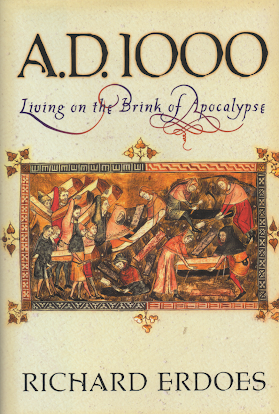First impressions review: AD 1000: Living on the Brink of Apocalypse, by Richard Erdoes
My mom gave me this book last Christmas, the same year I gave her a book set during the 1918 flu/WWI - because what better time than a pandemic to read about other times people thought the world was ending? This is a short book that aims to give a snapshot of life in Europe and neighboring areas on the edge of the first millennium AD, framed around the life of an unusual pope, the scholarly Gerbert de Aurillac, AKA Sylvester II.
The book begins with a crowd gathered at St. Peter’s Basilica on the last night of 999 AD waiting for “the Day of Wrath” – the second coming, the Apocalypse, the end of the world in some form. The author notes that many educated people inside and outside the church didn’t believe the millennium had much significance “but the common people, the lower nobles, village priests, and peasants, took it as an absolute truth that the ‘nightfall of the universe was at hand’”. People saw signs of this impending end in any ominous event, and mass hysteria was common. But not everything was filth, panic, and violence in this tumultuous century.
In terms of highlighting Gerbert, the book could have been structured better. It keeps digressing to talk about the culture and history of different countries or to tell other people’s stories, such that it is hard to maintain the thread of Gerbert’s life. That’s a shame, because he is indeed really interesting. He was (probably) of humble birth but gained access to education and advancement through the church, learning the Trivium (grammar, logic, & rhetoric) at his original abbey before being sent on to Barcelona to continue his studies. Gerbert’s favorite subject was mathematics, and he was probably responsible for introducing Arabic numerals, the decimal system, and the abacus to western Europe. But he loved all forms of learning, and “lusted after books as a lecher after voluptuous women.” He knew of the astronomical work that showed the earth was a globe, and traded the armillary spheres he built for rare volumes; interestingly, none of his recorded requests were for religious texts! Not that Gerbert was a heretic or atheist – though he would be accused of such things – but he argued for a broader form of learning and intellectual activity. Gerbert was called on to be a tutor of the son of the Holy Roman Emperor Otto, who eventually puts him in line to be named pope. But first, while still less than 30, he became head of the cathedral school in Rheims. Unusually, he encouraged his students to read poetry by pagan authors to develop their oratory: “I am not one to separate the useful from the beautiful…To be able to persuade and restrain with words of sweet eloquence the violence of lawless men is useful in the highest degree”. As if all that wasn’t enough, he invented the idea of musical staves, and ut (do), re, mi, fa, so, la to represent a 6-note scale. Gerbert was made abbot of Bobbio and bishop of Rheims but lost his positions first through coming into conflict with lords and churchmen who tried to suck profit out of these properties, then by getting temporarily excommunicated for supposedly usurping the position. He also got involved in the political maneuverings that brought the Capetians to the throne of what would become France. Otto III ensured that his teacher became pope in 999 AD; Gerbert took the name Sylvester II, after the Sylvester who had been pope when Constantine was emperor. But Otto III, a rather mercurial young man, was no Constantine, and Gerbert/Sylvester had to fight rumors that he practiced occult arts or was even the antichrist himself. Not that all chroniclers credited such tales; German historian Gregovorius wrote: “Gerbert in Rome is like a solitary torch in the darkness of the night. The century of grossest ignorance closed strangely enough with the appearance of a renowned genius…But Rome can merely claim the honor of having served as the scene of his studies which have met with no response.”
The digressions are interesting and mostly accurate. An early one highlights my favorite, medieval Spain: “In…Al Andalus…philosophy, literature, poetry, and the arts flourished…They rotated crops, terraced hills, and were experts at grafting and pruning… doctors had to be licensed and to undergo an examination in anatomy, herbalogy, and chemistry…Cordovan society was relaxed and tolerant.” Part of the reason Gerbert was suspected of heresy or satanism is due to his links to Islamic learning. We also meet the Romans, the Byzantines, the Germanic people, and the Vikings. The description of the Slavs is unusually insulting, though, seeming to take the contemporary accounts more literally than for some other groups: “Slow-moving, tow-headed folk...At one time, during the ninth century, they managed to expel their Nordic masters but then fell into such disorder that they asked the Rus to come back and rule over them again.” Arabic-speaking traders depict them as being happy to sell off their women to foreigners, which seems somewhat unlikely. However, I’m not well-versed enough in that corner of medieval history to assess whether my impression of bias is correct. The author notes that we don’t have local contemporary accounts; but is there no oral history that was later written down? And I am pretty sure it’s not true that “all the world’s mythologies” contain an apocalypse – those stories just tend to be memorable!
One of the other historical figures who gets a substantial mention is Queen Adelaide, who I think absolutely deserves a movie! She was married off to the young Duke of Burgundy, but he was poisoned by his rival Berengar. The people of northern Italy turned to the young widow as Berengar’s rule turned more oppressive, so he and his wife imprisoned Adeleide and tried to force her to marry their son. Adelaide and her two maidservants managed to escape, but she was caught, beaten up, and imprisoned in an island castle. A priest named Warinus started digging a hole in the castle wall, while Adelaide and her remaining maid dug from the inside. They rowed across the lake and went on the run, hiding in a wheat field from pursuers who stabbed blindly into the grain with their lances. After various adventures, they took refuge in a castle, which Berengar immediately besieged, but Warinus slipped through the lines to reach the HRE Otto II, saying Adelaide offered her hand and northern Italy if he’d come to her aid – which he did. They seem to have taken a liking to each other, as they stayed in each other’s favor despite various affairs on each side and had five children together. Adelaide had a say in many affairs of state, and was called Literatissima Regina, the most learned queen. She clashed at times with her formidable mother in law, Queen Matilda, but the two managed to put aside their differences in the interest of aiding Adelaide’s son, Otto II, in keeping control of the HRE. Adelaide was later regent of Otto III, who came to the throne at the age of three; he cast her aside when he was fourteen, though he regretted his bluntness and wrote her a letter thanking her for all she had done for him. She devoted the end of her life to pious works and died in 999.
Overall recommendation: I would mostly recommend this book to those who are fairly new to medieval history. It is a short book that illustrates the diversity of cultures within the medieval world and has a lot of interesting anecdotes. But if you are already fairly familiar with this historical period it can drag a bit as you wait to get to something new, like the extremely interesting lives of Gerbert and Adelaide.


